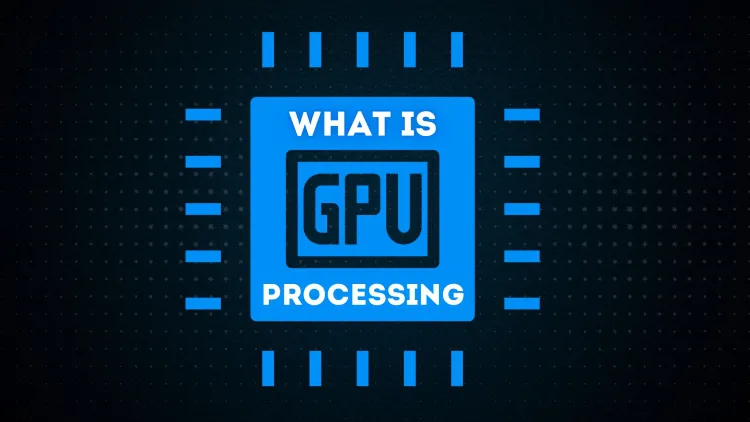What is GPU Programming? A Comprehensive Guide
GPU programming allows developers to harness the power of GPUs for high-performance parallel computing. By breaking tasks into smaller operations and using tools like CUDA and OpenCL, developers can achieve faster computation for AI, scientific research, gaming, and more. Although it comes with challenges like complexity and debugging, the benefits in speed, efficiency, and scalability make GPU programming a cornerstone of modern computing.

In today’s era of high-performance computing, GPU programming stands out as a transformative technology. While originally designed for rendering images, Graphics Processing Units (GPUs) now power applications ranging from advanced video games to AI model training. Let’s explore the fundamentals of GPU programming, how it works, its real-world applications, and why it is essential for modern computing.
What is GPU Programming?
GPU programming refers to the process of writing and optimizing code to harness the parallel processing power of GPUs. Unlike traditional CPUs, which excel at handling sequential tasks, GPUs are built to process thousands of smaller tasks simultaneously, making them perfect for compute-intensive applications.
Common Uses of GPU Programming
- Graphics rendering
- Scientific simulations
- Deep learning and AI training
- Cryptocurrency mining
GPU vs. CPU: Key Differences
| Feature | CPU | GPU |
|---|---|---|
| Processing Units | Fewer, but more powerful cores | Thousands of smaller, efficient cores |
| Task Handling | Sequential task execution | Parallel task execution |
| Usage | General-purpose computing | Compute-intensive, parallel workloads |
How Does GPU Programming Work?
GPU programming involves breaking down tasks into smaller operations that can run in parallel. Developers leverage specialized tools and frameworks to write code optimized for GPU architecture.
Step-by-Step Process
-
Write Code for Parallel Tasks
Developers identify parts of the task that can be executed concurrently, such as matrix operations in machine learning. -
Use GPU-Specific Frameworks and Tools
Common tools include:- CUDA (NVIDIA): A proprietary framework designed for NVIDIA GPUs.
- OpenCL: A cross-platform standard for programming GPUs and other accelerators.
- HIP: Optimized for AMD GPUs.
-
Memory Management
Data is transferred from the CPU to the GPU memory, ensuring fast access and efficient processing. -
Kernel Execution
Kernels (small parallel programs) are executed across thousands of GPU cores simultaneously.
Applications of GPU Programming
1. Artificial Intelligence and Machine Learning
AI model training requires handling millions of operations, like matrix multiplications, which GPUs accelerate significantly. Popular AI libraries like TensorFlow and PyTorch rely on GPU programming.
2. Scientific Simulations
Simulations in fields like physics, chemistry, and biology benefit from the massive computational capabilities of GPUs.
3. Cryptography and Blockchain
GPUs are widely used in cryptocurrency mining, where solving cryptographic problems involves intensive computation.
4. Video Game Development
Modern games with high-quality, real-time graphics use GPU programming for rendering.
5. Image and Video Processing
Rendering 3D models, video editing, and encoding tasks use GPU acceleration to achieve faster results.
Benefits of GPU Programming
- Speed: GPUs process multiple calculations at once, making them faster for parallel tasks.
- Energy Efficiency: They consume less energy compared to CPUs for similar workloads.
- Cost-Effectiveness: GPUs provide excellent performance at a lower cost for computationally heavy tasks.
- Scalability: Developers can scale applications across multiple GPUs for even greater performance.
Best Practices for GPU Programming
- Understand the Hardware: Know the architecture of the GPU to write efficient code.
- Optimize Memory Usage: Minimize data transfers between GPU and CPU memory to reduce latency.
- Optimize Kernels: Focus on writing lightweight kernels that utilize the full potential of GPU cores.
- Use Profiling Tools: Tools like NVIDIA Nsight help identify performance bottlenecks and optimize code.
Challenges in GPU Programming
- Complexity: Writing GPU-optimized code requires a solid understanding of parallel computing.
- Debugging Issues: Parallel nature of GPUs can make debugging more challenging.
- Portability: Code optimized for one GPU architecture might not work efficiently on others.
Future of GPU Programming
As industries like AI, data science, and gaming continue to grow, the importance of GPU programming will only increase. Emerging trends, such as GPU-accelerated cloud computing and heterogeneous computing, will expand the possibilities even further.
Conclusion
GPU programming has transformed the computing landscape, offering unmatched speed, efficiency, and scalability for complex tasks. Whether you’re training AI models, simulating scientific phenomena, or developing video games, GPU programming opens the door to groundbreaking possibilities in high-performance computing.
FAQs
-
What is GPU programming?
It’s the process of using GPUs to perform computations faster through parallel processing. -
What makes GPUs faster than CPUs for some tasks?
GPUs have thousands of cores designed for parallel execution, making them faster for tasks involving large datasets. -
Which languages are used for GPU programming?
CUDA, OpenCL, and HIP are common programming languages for GPUs. -
What are kernels in GPU programming?
Kernels are small programs executed in parallel on GPU cores. -
What is CUDA?
CUDA is a GPU programming platform and API developed by NVIDIA. -
Is GPU programming only for AI and gaming?
No, it’s used in cryptography, scientific research, and more. -
How does GPU memory differ from CPU memory?
GPU memory is optimized for fast parallel access, while CPU memory handles sequential operations. -
What is OpenCL?
OpenCL is a cross-platform framework for programming GPUs and other accelerators. -
What industries use GPU programming?
AI, gaming, scientific research, cryptography, and video processing are some of the key industries. -
Why is GPU programming important?
It enables faster and more efficient processing for compute-intensive applications.











![Top 10 Ethical Hackers in the World [2025]](https://www.webasha.com/blog/uploads/images/202408/image_100x75_66c2f983c207b.webp)



![[2025] Top 100+ VAPT Interview Questions and Answers](https://www.webasha.com/blog/uploads/images/image_100x75_6512b1e4b64f7.jpg)







